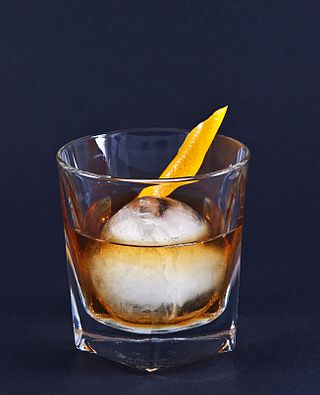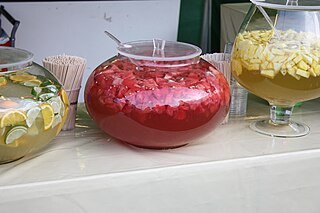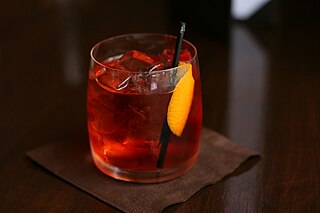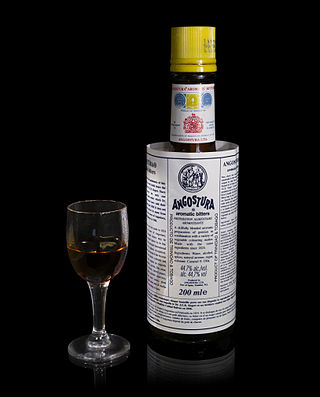Related Research Articles

A Manhattan is a cocktail made with whiskey, sweet vermouth, and bitters. While rye is the traditional whiskey of choice, other commonly used whiskies include Canadian whisky, bourbon, blended whiskey, and Tennessee whiskey. The cocktail is usually stirred with ice then strained into a chilled cocktail glass and garnished traditionally with a maraschino cherry. A Manhattan may also be served on the rocks in a lowball glass.

The old fashioned is a cocktail made by muddling sugar with bitters and water, adding whiskey, and garnishing with an orange slice or zest and a cocktail cherry. It is traditionally served with ice in an old fashioned glass.

The Rob Roy is a cocktail consisting primarily of whisky and vermouth, created in 1894 by a bartender at the Waldorf Astoria in Manhattan, New York City. The drink was named in honor of the premiere of Rob Roy, an operetta by composer Reginald De Koven and lyricist Harry B. Smith loosely based upon Scottish folk hero Rob Roy MacGregor.

The martini is a cocktail made with gin and vermouth, and garnished with an olive or a lemon twist. Over the years, the martini has become one of the best-known mixed alcoholic beverages. A popular variation, the vodka martini, uses vodka instead of gin for the cocktail's base spirit.

The term punch refers to a wide assortment of drinks, both non-alcoholic and alcoholic, generally containing fruits or fruit juice. The drink was introduced from the Indian subcontinent to England by employees of the East India Company in the late 17th century. Punch is usually served at parties in large, wide bowls, known as punch bowls.

A Negroni is a cocktail, made of equal parts gin, vermouth rosso, and Campari, commonly garnished with an orange slice or orange peel. It is considered an apéritif. The origin is uncertain; though the name and most ingredients are Italian, the recipe is first recorded in French cocktail books of the 1920s – see § History for details.

A sour is a traditional family of mixed drinks. Sours belong to one of the old families of original cocktails and are described by Jerry Thomas in his 1862 book How to Mix Drinks.

Angostura bitters is a concentrated bitters based on gentian, herbs, and spices, produced by House of Angostura in Trinidad and Tobago. It is typically used for flavouring beverages, or less often, food. The bitters were first produced in the town of Angostura, hence the name, but do not contain angostura bark. The bottle is recognisable by its distinctive oversized label. Angostura is Spanish for "narrowing", the town of Angostura having been at the first narrowing of the Orinoco River.

The Prince of Wales is a cocktail created by Albert Edward, Prince of Wales, who later became King Edward VII. There are several variations of the cocktail, but what they usually have in common is champagne, angostura bitters, sugar, either rye whiskey or cognac, and a liqueur.

The Fine Art of Mixing Drinks is a book about cocktails by David A. Embury, first published in 1948. The book is noteworthy for its witty, highly opinionated and conversational tone, as well as its categorization of cocktails into two main types: aromatic and sour; its categorization of ingredients into three categories: the base, modifying agents, and special flavorings and coloring agents; and its 1:2:8 ratio for sour type cocktails.

The Carousel Piano Bar & Lounge is the only revolving bar in New Orleans, Louisiana. The bar is inside the Hotel Monteleone and overlooks Royal Street in the French Quarter of New Orleans. Installed in 1949, the 25-seat circular bar turns on 2,000 large steel rollers, powered by a 1⁄4 hp (190 W) motor. The bar rotates at a rate of one revolution every 15 minutes. In addition to the rotating bar, an adjoining room includes booths and tables with live entertainment offered nightly.

The Malecon is a cocktail named after the El Malecón, the winding beachfront avenue atop the seawall in Havana, Cuba.
The corpse reviver family of named cocktails are sometimes drunk as alcoholic hangover tongue-in-cheek "cures", of potency or characteristics to be able to revive even a dead person. Some corpse reviver cocktail recipes have been lost to time, but several variations commonly thought to be tied to the American Bar at the Savoy Hotel remain, especially those espoused by Harry Craddock that originally date back to at least 1930 and are still being made. Many "reviver" variations exist and the word is sometimes used as a generic moniker for any morning-after cocktail, also known as a "hair of the dog".
The Blackthorn is an Irish whiskey or sloe gin based cocktail. Both versions emerged in the late 19th and early 20th century.

The doctor cocktail is a pre-prohibition era cocktail that traces in drink guides to as far back as 1917, when it appeared in Hugo R. Ensslin's Recipes for Mixed Drinks. As originally described the cocktail called simply for Swedish Punsch mixed with lime juice.
The test pilot cocktail is a vintage tiki drink invented by Donn Beach. Beach was known for changing his recipes over time, and multiple versions of the test pilot attributed to both him and others make the cocktail one of his more frequently imitated and varied tiki drinks. Test pilot recipes call for multiple rums and typically include the use of falernum syrup and lime juice. The more popular also include Pernod (pastis/absinthe) and bitters.

The Martinez is a classic cocktail that is widely regarded as the direct precursor to the Martini. It serves as the basis for many modern cocktails, and several different versions of the original exist. These are generally distinguished by the accompaniment of either Maraschino or Curacao, as well as differences in gin or bitters.

A whiskey cocktail is a cocktail that includes whiskey. Although whiskey is often served neat or on the rocks, it is used in many classic cocktails such as the Old Fashioned, Manhattan, and Julep. Some specifically call for Scotch whisky or bourbon whiskey.
References
- ↑ Duffy, Patrick (1956). The Official Mixer's Manual. New York: Garden City Books. p. 96.
- ↑ Tarling, W.J. (1937). Cafe Royal Cocktail Book (Coronation ed.). London: Pall Mall. p. BO.
- ↑ Craddock, Harry (1934). The Savoy Cocktails Book. London: Constable & Co. p. 33.
- ↑ Gaige, Crosby (1944). Standard Cocktail Guide (Third ed.). New York: Bardows & Co. p. 37.
- ↑ Vermier, Robert. Cocktails: How to Mix Them (second ed.). London: Herbert Jenkins LTD. p. 20.
- ↑ Bosker, Gideon (1998). Atomic Cocktails. San Francisco: Chronicle Books. p. 8.
- ↑ Berry, Jeff (2010). Beachbum Berry Remixed. San Jose, California: Club Tiki Press. p. 30.
- ↑ "The secret vocabulary of New York's finest drinking establishments". The New York Times. 15 February 2014. Retrieved 6 February 2019.
- ↑ "Boomerang: the secret world of messengered cocktails". punchdrink.com. Retrieved 6 February 2019.
- ↑ "Boomerang Cocktails are bartenders secret". thestar.com. 24 June 2016. Retrieved 6 February 2019.
- ↑ "Boomerang Cocktails". toniqueepicure.com. Archived from the original on 20 October 2015. Retrieved 6 February 2019.